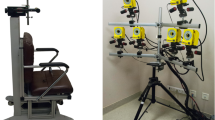Abstract
The prognostic value of electromyography (EMG) and its significance to estimate facial function outcome after acute facial palsy is still unclear. We retrospectively analysed the EMG reports of 494 patients with acute facial palsy treated from 1995 to 2005 in a tertiary referral centre. Initial and final facial functions were assessed by the House–Brackmann (HB) scale. Serial EMG results were classified into neurapraxia, axonotmesis/neurotmesis, mixed lesion, complete recovery, defective healing, or not classifiable. Initial HB was II–IV in 321 patients and V–VI in 173 cases. The aetiology was idiopathic palsy in 294, iatrogenic lesion in 86, traumatic in 52, Herpes zoster in 37, and of various origin in 25 patients. EMG revealed neurapraxia in 300 patients, axonotmesis/neurotmesis in 95 patients, and mixed lesion in 23 cases. EMG was not meaningful in 76 patients. The follow-up time ranged from 0.3–264 months. Final EMG revealed a full recovery in 160 patients, whereas 219 patients showed signs of defective healing. In 155 patients, EMG was not significant to classify the final outcome. The predictive EMG value for poor outcome was 77–86% and for recovery 53%. The mean EMG recovery time was 2.3 months. Mean time for defective healing was 4.3 months. Final HB was normal (HB I) in 323 patients, HB II–IV in 115 patients, and V–VI in 46 patients. We conclude that EMG has a high predictive value for unfavourable outcome after acute facial palsy. EMG is more sensible to detect signs of defective healing than clinical evaluation of facial function.
Similar content being viewed by others
References
Celik M, Forta H, Vural C (2000) The development of synkinesis after facial nerve paralysis. Eur Neurol 43:147–151
Dalla TE, Bossi D, Buonocore M, Montomoli C, Petrucci L, Alfonsi E (2005) Usefulness of BFB/EMG in facial palsy rehabilitation. Disabil Rehabil 27:809–815
Guntinas-Lichius O (2006) Objective computerized versus subjective analysis of facial synkinesis. Laryngoscope 116:845; author reply 845–846
Guntinas-Lichius O, Beurskens CH, van Gelder RS, Heymans PG, Manni JJ, Nicolai SPA (2005) The facial nerve grading systems. In: The facial palsies. Lemma Publishers, Utrecht, p 51–68
Guntinas-Lichius O, Streppel M, Stennert E (2006) Postoperative functional evaluation of different reanimation techniques for facial nerve repair. Am J Surg 191:61–67
House JW (1983) Facial nerve grading systems. Laryngoscope 93:1056–1069
Lee DH, Chae SY, Park YS, Yeo SW (2006) Prognostic value of electroneurography in Bell’s palsy and Ramsay-Hunt’s syndrome. Clin Otolaryngol 31:144–148
Linstrom CJ (2002) Objective facial motion analysis in patients with facial nerve dysfunction. Laryngoscope 112:1129–1147
Ljostad U, Okstad S, Topstad T, Mygland A, Monstad P (2005) Acute peripheral facial palsy in adults. J Neurol 252:672–676
Peitersen E (2002) Bell’s palsy: the spontaneous course of 2,500 peripheral facial nerve palsies of different etiologies. Acta Otolaryngol Suppl 549:4–30
Seddon H (1943) Three types of nerve injury. Brain 66:237–288
Sittel C, Guntinas-Lichius O, Streppel M, Stennert E (1998) Variability of repeated facial nerve electroneurography in healthy subjects. Laryngoscope 108:1177–1180
Sittel C, Sittel A, Guntinas-Lichius O, Eckel HE, Stennert E (2000) Bell’s palsy: a 10-year experience with antiphlogistic-rheologic infusion therapy. Am J Otol 21:425–432
Sittel C, Stennert E (2001) Prognostic value of electromyography in acute peripheral facial nerve palsy. Otol Neurotol 22:100–104
Author information
Authors and Affiliations
Corresponding author
Rights and permissions
About this article
Cite this article
Grosheva, M., Guntinas-Lichius, O. Significance of electromyography to predict and evaluate facial function outcome after acute peripheral facial palsy. Eur Arch Otorhinolaryngol 264, 1491–1495 (2007). https://doi.org/10.1007/s00405-007-0376-z
Received:
Accepted:
Published:
Issue Date:
DOI: https://doi.org/10.1007/s00405-007-0376-z




